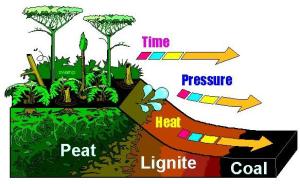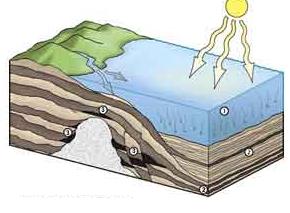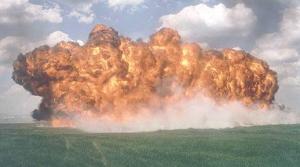COAL FORMATION
Like oil and gas, coal is a fossil FUEL which means it can be burned to generate heat energy.
It was formed very slowly, a very long time ago. Once used up, it takes millions of years to make more so it is NON-RENEWABLE
 300 million years ago, it was the Carboniferous Age on Earth. The land that had emerged from the sea was covered with enormous forests. In certain places, these forests were submerged underwater at regular intervals beneath the sea or marshes. The wood, instead of rotting on the surface, was rapidly covered with mud and sand. Over thousands of years, the forest took over again, and then it was submerged as before, and so on. Little by little, the sediments carried by rivers or the sea covered these layers of dead wood, gradually hardening into lignite. As these sediments built up, the wood sank deeper and deeper into the ground. We know that the further we go down into the earth, the hotter it becomes. This heat and the enormous pressure of the sediments gradually transformed (over time) the wood into coal.
300 million years ago, it was the Carboniferous Age on Earth. The land that had emerged from the sea was covered with enormous forests. In certain places, these forests were submerged underwater at regular intervals beneath the sea or marshes. The wood, instead of rotting on the surface, was rapidly covered with mud and sand. Over thousands of years, the forest took over again, and then it was submerged as before, and so on. Little by little, the sediments carried by rivers or the sea covered these layers of dead wood, gradually hardening into lignite. As these sediments built up, the wood sank deeper and deeper into the ground. We know that the further we go down into the earth, the hotter it becomes. This heat and the enormous pressure of the sediments gradually transformed (over time) the wood into coal.
OIL AND GAS FORMATION
 Oil is another fossil fuel. It was also formed more than 300 million years ago. Some scientists say that tiny diatoms are the source of oil. Diatoms are sea creatures the size of a pin head. They do one thing just like plants; they can convert sunlight directly into stored energy.
Oil is another fossil fuel. It was also formed more than 300 million years ago. Some scientists say that tiny diatoms are the source of oil. Diatoms are sea creatures the size of a pin head. They do one thing just like plants; they can convert sunlight directly into stored energy.
As the diatoms died they fell to the sea floor (1). Here they were buried under sediment and other rock (2). The rock squeezed the diatoms and the energy in their bodies could not escape. The carbon eventually turned into oil under great pressure and heat. As the earth changed and moved and folded, pockets where oil and natural gas can be found were formed (3).
Oil has been used for more than 5,000-6,000 years. The ancient Sumerians, Assyrians and Babylonians used crude oil and asphalt (“pitch”) collected from large seeps at Tuttul (modern-day Hit) on the Euphrates River. A seep is a place on the ground where the oil leaks up from below ground. The ancient Egyptians used liquid oil as a medicine for wounds, and oil has been used in lamps to provide light.
The Dead Sea used to be called Lake Asphaltites. The word ‘asphalt’ – the stuff we put on roads -is derived from this place because of the lumps of gooey, jelly-like black oily gunge that used to be washed up on the lake shores from underwater seeps.
Greek fire (which wasn’t invented by the Greeks at all) was probably a mixture of runny asphalt or pitch, naphtha, quicklime (calcium oxide) and sulphur, although nobody knows for sure. It was used in warfare to pour over the enemy troops from the castle walls. It burned furiously and couldn’t be put out easily with water. It was an early version of napalm which, as you can see, burns away quite nicely (!)
